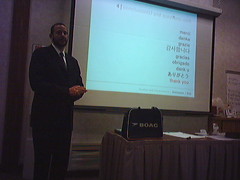The Satorialist has suddenly made a big splash in both the blogging and fashion worlds with a very simple idea: take photos of wonderfully-dressed everyday people on the street and post them on a blog. The author’s eye and insightful commentary create little moments of education and beauty. We knew about the threats to classifieds and news and encyclopedias, and this peck at the high-media establishment further demonstrates that everything — even the insular fashion publishing world — is subject to the democratization of publishing.
Next time you’re at the bookstore have a look around and wonder what wouldn’t benefit from a simpler or more social approach or a whole new perspective.
This photo is titled, What Every American Boy Dreams Parisian Girls Look Like. Sigh.

 Advertisement, Manhattan.
Advertisement, Manhattan.



 More from
More from 